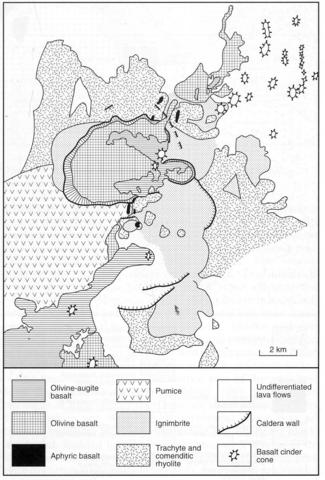stripes
The Koni volcanic centre is dominated by a series of calderas, eight of which have been identified by Cole (1969), although the earlier ones are much obscured by later volcanic products. The oldest rocks identified are trachyte flows containing phenocrysts of anorthoclase, fayalite and ferroaugite and these were followed by trachytes characterised by phenocrysts of anorthoclase, sodic ferrohedenbergite and fayalite with a sodic amphibole and aenigmatite in the groundmass of some types. Ignimbrites and pumices were then erupted which can probably be correlated with caldera formation. Individual ignimbrite sheets vary in thickness from 15 cm to 25 m and are usually graded from a welded base to a non- or poorly-welded top. The ignimbrites are peralkaline one containing ferrohedenbergite and aenigmatite. Within the pumice deposits, which are particularly widespread to the southwest, are inclusions of trachyte, ignimbrite and blocks of syenite that may comprise up to 25% by volume of the rock. The syenites are variable but usually contain augite, aegirine, anorthoclase, quartz and a sodic amphibole while aenigmatite, arfvedsonite and perthite occur in one variety. The last of the silicic eruptive phases is represented by flows of ferrohedenbergite-sodic amphibole rhyolite that built up a cone in the centre of the complex. Activity concluded with eruption of pahoehoe and aa flows of basalt from cinder cones that are generally confined to the youngest two calderas.
COLE, J.W. 1969. Gariboldi volcanic complex, Ethiopia. Bulletin Volcanologique, 33: 566-78.MOHR, P.A. 1962b. Surface cauldron subsidence with associated faulting and fissure basalt eruptions at Gariboldi Pass, Shoa, Ethiopia. Bulletin Volcanologique, 24: 421-28.

